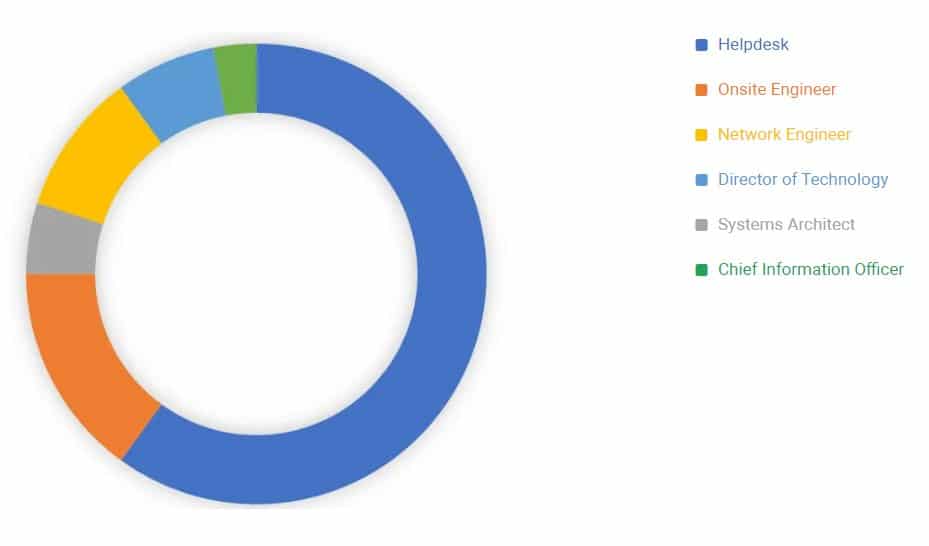Managed Service Provider
Are you debating between an in-house IT administrator vs. Managed Service Provider?
Information technology has seen a lot of changes during the past few years. Many of these changes can be attributed to the rapidly evolving effects of cloud technology, as well as a huge shift in the way people store, share, and access data.
For small and medium-sized businesses (SMBs), there are two schools of thought. One side sees IT investment as a cost center, a necessary evil. The other sees it as an opportunity to protect and optimize business processes, a competitive edge. Generation IX tends to partner with the ladder category. No matter the camp, business managers experience the same pain points they did 30 years ago:
- “I’ve determined we need IT support. Now what?”
- “How do I learn enough about IT to make an educated decision?”
- “Should we use an in-house or outsourced IT model?”
As a response to these problems – specifically the second one – a lot of business managers will hire an in-house engineer because they can more easily track their daily activities. Access to all of the data, the business manager plans to iterate and improve. Unfortunately, surveying the wrong variables and measuring the wrong results creates more data points without getting any closer to finding IT answers. Infrastructure complexity, risk tolerance, company style, business agility, and available budget are just a few of the variables to explore on the path to the right solution for your business.
Here we’ll discuss the differences between an in-house IT administrator vs. managed service provider (MSP). Additionally, we’ll provide color on what makes Generation IX a unique MSP. Continue reading this page, or use the links below to jump to a specific section.
- The different IT support roles
- Strategy for retaining talented engineers
- What is the cost breakdown?
- Customer service
- New technology testing/implementation
- Personnel backup plan
- Industry specific technology needs
The different IT support roles
Below is the full spectrum of opportunities available for IT professionals.

Heldesk Technician

Helpdesk Manager

Service Engineer

Advanced Service Engineer

Systems Architect

Network Engineer

Senior Network Engineer

Project Manager

Director of Technology

Director of Client Services

Chief Technology Officer

Chief Information Officer
SMB IT broken down by role:
Small and medium-sized businesses require 60% helpdesk, 15% on-site engineer, 5% systems architect, 10% network engineer, 7% director of technology, and 3% Chief Information officer.

How do SMBs service all of these categories?
Here are two successful in-house IT administrator models:
(1) For a growing business with minimal IT complexity/needs: hire a hungry service engineer and he/she can learn and grow alongside the business.The career path for the helpdesk engineer is hinging on company growth and continual reinvestment by the company into his/her education.
(2) For a more mature business, with an office manager fluent in IT, hire a more seasoned Network Engineer. At a minimum, a Network Engineer will be required to handle backend configurations. The ideal engineer, for this scenario, works to live. He/she has more motivation or passion outside of his/her career and does not want more responsibility or complexity. This will keep him/her from leaving to a larger organization.
MSPs employ the full spectrum of roles. Therefore, their clients have the ability to tap each resource in the amount that fits their need.
Strategy for retaining talented engineers
In-House IT Administrator vs. Managed Service Provider (Gen IX)
At Generation IX, we pride ourselves on our engineers. We continually hire from the top of the talent pool; they are inventive and interesting.
Three (3) reasons Gen IX retains talent:
- Clear promotional track: opportunities to take on more responsibility with greater complexity.
- Camaraderie: Mentor/Mentee relationship between engineers. Most importantly, because engineers speak a different language they appreciate working with other people who speak “techie.”
- Exposure to multiple environments: Our engineers enjoy the different challenges each client presents. They view new challenges as opportunities to embrace new technology and push the industry forward.
For the in-house model:
In-house administrators don’t like change. They prize the consistency of a perfectly built system. If they built it themselves, even better. The systems they design focus on controlling as many variables as possible. Without change, a well-built system will run smoothly with minimal maintenance and less work for the supporting engineers. New technology represent change. Therefore, in-house IT teams don’t embrace different technologies. Moreover, they rarely fit in dynamic businesses; they better harmonize with larger enterprises or slower moving companies.
What is the cost breakdown?
With Generation IX’s fixed structure, our clients have the full range of support for a fixed monthly cost. Generation IX’s cost structure is composed of 3 parts:
- Onboarding/Assessment– Variables affecting cost: Complexity of the network, status of previous IT infrastructure/documentation, expediency of timeline, compliance of staff
- Regular monthly support – Includes cyber defense, on-site support, remote helpdesk, 24/7 network monitoring, executive home support
- Projects – For example: Moving offices, Office 365 migrations, Upgrading server infrastructure
SMBs cannot afford to hire all of the different roles. How do they weigh certain skill sets over others? To determine which roles will have the highest ROI, here are a few questions to probe.
- Where can we invest in new hardware to improve our current infrastructure and make it easier to manage?
- What is 75% of our IT need?
- What will it cost me to cover the remaining 25%? Is there an option other than hourly rates?
Small businesses need to stay nimble to out compete their competitors. Consequently, scalability of support weighs heavy in the financial discussion. It’s impossible to hire half a person; in contrast, it’s viable to increase a regular support contract by 50 percent.
Cost Comparison
60 users with moderately complex backend environment

In-House IT Team
One desktop support engineer +
One Network Engineer
First year costs: $211,000
Average over 3 years: $190,000

In-House + Gen IX
One desktop support engineer +
Generation IX support
First Year Total: $190,000
Average over 3 years: $160,000

Generation IX support
First year total: $172,000
Average over 3 years: $155,000
* For a more detailed cost comparison: Click here
Customer Service
In-House IT Administrator vs. Managed Service Provider
Human Connection
Generation IX delivers exceptional customer service with in person tech support and regular reporting. Most managed service providers (MSPs) optimize their business model for remote support. In contrast, Generation IX shapes its contracts around regular on-site support; we spotlight the human connection between engineer and end user. Although most issues can be resolved remotely, we connect with all employees to ensure no one is “suffering in silence.”
Great Documentation Great Reporting
For the client’s benefit, MSPs should be thorough in their documentation. The benefit of great documentation is twofold. First, we produce reports for our clients detailing any project updates and outstanding issues. Second, god forbid one of our clients decide to switch IT providers, we can provide the new company or personnel with a detailed picture of the past, present, and future IT infrastructure.
In-House IT Administrator vs. Managed Service Provider
Employing an in-house engineer assures a consistent on-site presence. Always providing the human to human connection, an in-house employee will be on-site to help with any issues that may arise during the normal work day. Additionally, documentation is less important for in-house engineers. They are the only one managing the backend; therefore, they don’t need to document passwords and network specifics.
New technology testing/implementation
In-House IT Administrator vs. Managed Service Provider
Generation IX beta tests new technology solutions internally before rolling out to our clients. Recreating workflows as close as possible, we try hard to break it before our clients buy it. After the internal testing phase, we educate our clients on the changes in client workflows, potential pitfalls, and differences between vendor marketing and actual capabilities. If the client finds the features outweigh the cost, we introduce the new product or service. Consequently, our clients benefit from a thorough screening process before purchasing each new technology. Methodical and measured adoption, our process is focused on long term success with minimal short-term disruptions.

Step 1: Internal testing
Recreating workflows as close as possible, we try hard to break it before our clients buy it.

Step 2: Analyze cost/benefits for client
Educate our clients on the changes in client workflows, potential pitfalls, and differences between vendor marketing and actual capabilities.

Step 3: Implement at first client

Step 4: Rinse and Repeat
In-House IT Administrator vs. Managed Service Provider
In-house IT teams don’t have the luxury of beta testing new technology solutions. This creates two challenges. The first challenge: how to determine if a new product/service can help the business. Typically, the COO will take on the equivalent of a CIO or CTO role. It helps to be a step behind and learn from industry peers at other companies. The second challenge: how to implement a new product/service without any experience in it. For this, small businesses would hire companies like Generation IX.
Personnel backup plan
In-House IT Administrator vs. Managed Service Provider
Employing a company instead of an individual, creates inherent redundancy into your systems. Gen IX’s staff backup strategy covers every level of support.
Backup option at each level of IT support:
- Helpdesk: When a client calls the remote helpdesk, no matter who answers, the client receives personalized support. Not a stranger on the other end.
- On-site support: If the typical on-site engineer is on vacation, calls in sick, or is unavailable for any reason we have another engineer plug in without any disruption.
- Network Engineer: Networking issues can be solved in a variety of different ways. Our engineers collaborate on each new problem, bringing in unique perspectives to come to the most effective client solution.
- Client Services: Our duet of client success managers creates redundancy in communication, ensuring the messaging is heard.
In-House IT Administrator vs. Managed Service Provider
For an SMB, on average we see one (1) in-house engineer per 30 employees. This means a purely in-house IT team lacks personnel redundancy until you reach 60 employees. To make up for this, the majority of SMBs maintain a relationship with an outsourced provider, “just in case.” Gen IX acts as inhouse redundancy for a variety of clients.
* When we are backup support only, we require some level of regular support contract and typically a quarterly on-site visit. To support a system, we need to know it.
Industry specific technology needs
Partner with a software expert
Every industry has specific software applications integral to daily operations. Generation IX supports industry specific tools and applications in a few ways. First, we align with the client “champion.” The champion is the internal expert on the application. To better understand our clients’ workflows, we schedule regular technology meetings with the champion. During these regularly scheduled meetings, we debrief with the representative, road map upgrades, discuss product changes, and explore any network limitations affecting the application.
IT Meeting Overview:
- Debrief on any upcoming company changes for the client
- Review any IT related questions or concerns
- Road map any short or long term changes to IT
- Discuss any
Vet new products
Additionally, we help vet new products or services for our clients. We understand the underlying framework; therefore, we can investigate prospective software/hardware applications to uncover the validity of the marketing message. Lastly, majority of software/hardware problems are solved through a solid network infrastructure design and an understanding of client workflows.
In-House IT Administrator vs. Managed Service Provider
In-house engineers can focus on tools, applications, and processes specific to the company’s needs. This dynamic capacity can allow them to wear lots of different hats. Small business IT departments occasionally spring out of the software experts. They might be hired for a completely different role. However, the line between software and information technology can blur in SMBs. As businesses grow and shrink, the software champion can wear the IT support hat as well. Not recommend as a long-term solution, but it works as a great band aid.
Conclusion
From cost to IT talent, Generation IX differentiates its services by emphasizing human interaction, and by understanding end user workflows with regards to company specific needs. Focus on revenue generating opportunities, and let Gen IX take care of your IT. Most importantly, Gen IX knows Los Angeles-based small businesses. We’ve supported them for over 30 years and pride ourselves on being one as well. Go Dodgers!




